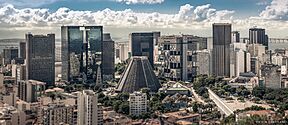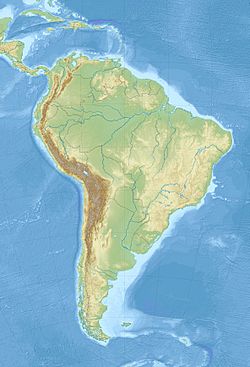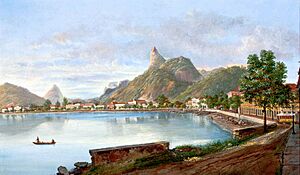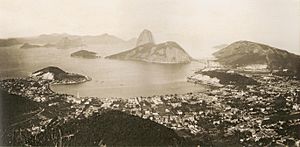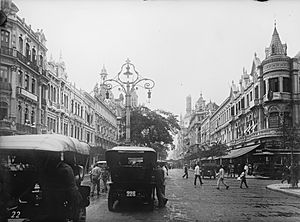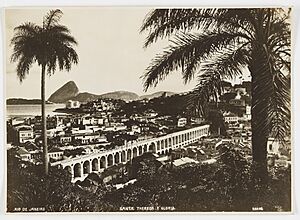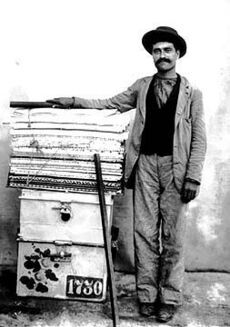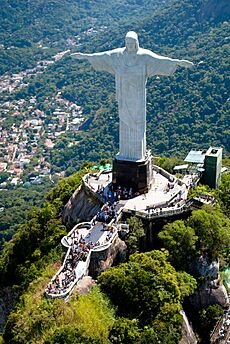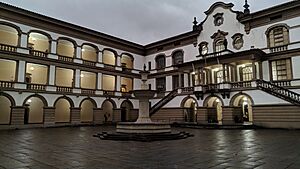Rio de Janeiro facts for kids
Quick facts for kids
Rio de Janeiro
|
|||
|---|---|---|---|
|
Municipality
|
|||
| Municipality of Rio de Janeiro | |||
|
Christ the Redeemer on Corcovado with Sugarloaf Mountain and Guanabara Bay (background)
Theatro Municipal
Museum of Tomorrow
Barra da Tijuca
Downtown Rio from Santa Teresa, with the Metropolitan Cathedral (center), Carioca Aqueduct (right) and Rio-Niteroi Bridge (background)
|
|||
|
|||
| Nicknames:
Cidade Maravilhosa (Marvellous City), Princesa Maravilhosa (Marvellous Princess), Cidade dos Brasileiros (City of Brazilians)
|
|||
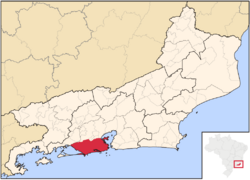
Location in the state of Rio de Janeiro
|
|||
| Country | Brazil | ||
| Region | Southeast | ||
| State | Rio de Janeiro | ||
| Historic countries | Kingdom of Portugal United Kingdom of Portugal, Brazil and the Algarves Empire of Brazil |
||
| Settled | 1555 | ||
| Founded | 1 March 1565 | ||
| Named for | Saint Sebastian Guanabara Bay |
||
| Government | |||
| • Type | Mayor-council | ||
| • Body | Municipal Chamber of Rio de Janeiro | ||
| Area | |||
| • Municipality | 1,221 km2 (486.5 sq mi) | ||
| • Metro | 4,539.8 km2 (1,759.6 sq mi) | ||
| Elevation | 2 m (7 ft) | ||
| Highest elevation | 1,020 m (3,349 ft) | ||
| Lowest elevation | 0 m (0 ft) | ||
| Population
(2022)
|
|||
| • Municipality | 6,211,223 | ||
| • Rank | 4th in South America 2nd in Brazil |
||
| • Density | 5,174.6/km2 (13,402/sq mi) | ||
| • Urban | 11,616,000 | ||
| • Metro | 12,280,702 (2nd) | ||
| • Metro density | 2,705.1/km2 (7,006/sq mi) | ||
| Demonym(s) | Carioca | ||
| GDP (PPP, constant 2015 values) | |||
| • Year | 2023 | ||
| • Total (Metro) | $285.9 billion | ||
| • Per capita | $23,700 | ||
| Time zone | UTC−3 (BRT) | ||
| Postal Code |
20000-001 to 23799-999
|
||
| Area code(s) | 21 | ||
| HDI (2010) | 0.799 – high | ||
| Nominal 2018 GDP (City) | US$ 93.9 billion (2nd) | ||
| Per capita | US$14,046 (2nd) | ||
| Official name: Rio de Janeiro: Carioca Landscapes between the Mountain and the Sea | |||
| Type: | Cultural | ||
| Criteria: | vi | ||
| Designated: | 2012 (36th session) | ||
| Reference #: | 1100 | ||
Rio de Janeiro (pronounced Hee-oh dee Zhuh-NAY-roh), often called simply Rio, is a famous city in Brazil. It is the capital of the state of Rio de Janeiro. Rio is the second-largest city in Brazil by population, after São Paulo. It is also the sixth-largest city in all of the Americas.
The Portuguese founded Rio in 1565. It was an important city in the Portuguese Empire. In 1808, the Portuguese Royal Family moved to Rio to escape Napoleon's invasion of Portugal. This made Rio the capital of the Portuguese Empire, which was very unusual for a colony. Rio then became the capital of independent Brazil until 1960, when the capital moved to Brasília.
Rio de Janeiro has a strong economy. It has the second-largest city economy in Brazil. Many big Brazilian companies, especially in oil, mining, and telecommunications, have their main offices here. Rio is also a major center for research and development in Brazil.
This city is one of the most visited places in the Southern Hemisphere. It is famous for its beautiful natural scenery, the lively Carnival, and music styles like samba and bossa nova. Its beaches, like Copacabana and Ipanema, are known worldwide. Famous landmarks include the huge statue of Christ the Redeemer on Corcovado mountain, and Sugarloaf Mountain with its cable car. The Sambódromo is a special parade avenue used during Carnival. Maracanã Stadium is one of the world's largest football stadiums. Rio hosted the 2016 Summer Olympics and the 2016 Summer Paralympics, making it the first South American city to do so. It also hosted parts of the 1950 and 2014 FIFA World Cups. Rio will host the G20 summit in 2024 and the FIFA Women's World Cup in 2027.
Contents
Rio's History: From Colony to Modern City
Rio de Janeiro has a long and interesting history. It has changed from a small Portuguese settlement to a major world city.
Early Days: Before Europeans Arrived
Before Europeans came, the area of Rio was home to several native groups. These included the Tupi, Puri, Botocudo, and Maxakalí peoples.
Colonial Period: Portuguese Rule and French Attempts
Europeans first saw Guanabara Bay on January 1, 1502. This is why it was named "Rio de Janeiro," which means "January River." This discovery was made by a Portuguese expedition.
In 1555, French colonists tried to settle on Villegagnon Island in Guanabara Bay. They built Fort Coligny. The Portuguese saw this as a threat. After several years of fighting, the Portuguese finally drove the French out in 1567.
The city of Rio de Janeiro was officially founded by the Portuguese on March 1, 1565. It was named São Sebastião do Rio de Janeiro, honoring Saint Sebastian. For many years, the city faced attacks from French pirates.
In the late 1600s, gold and diamonds were found in a nearby region called Minas Gerais. This made Rio de Janeiro a very important port for shipping these treasures, along with sugar, back to Portugal. Because of its growing importance, Rio became the capital of Portuguese America in 1763.

During the colonial period, many African slaves were brought to Rio de Janeiro. Between 1811 and 1831, a huge number of slaves arrived at Valongo Wharf. This wharf is now a World Heritage Site. The Port of Rio de Janeiro was the largest port for slaves in the Americas.
Royal Period: Rio as a European Capital

In 1808, the Portuguese royal family moved their entire court to Rio de Janeiro. This was to escape Napoleon's invasion of Portugal. This made Rio the only European capital city ever located outside of Europe.
Many new schools and institutions were created during this time. These included the Military Academy and the National Library of Brazil. Brazil was made a kingdom in 1815. Rio remained its capital until the royal family returned to Portugal in 1821.
Imperial Period: Brazil's Capital
When Brazil became independent in 1822, Prince Pedro kept Rio de Janeiro as the capital of the new empire. The city grew with coffee farming in nearby areas. To separate the city from the surrounding state, Rio became a "Neutral Municipality" in 1834.
Rio was the center of political life in Brazil. It was also a key place for movements to end slavery and create a republic. The city developed with modern services like trams, gas lighting, and telephones. Rio remained the capital even after Brazil became a republic in 1889.
The Birth of Football in Brazil
In 1889, the Bangu Textile Factory was founded. British workers came to Bangu to work there. In 1894, a British worker named Thomas Donohoe brought a football to Bangu.
He was surprised that Brazilians didn't know about football. So, the first football match in Brazil happened in Bangu in September 1894. It was a small game between British workers. This was six months before the more famous first game organized by Charles William Miller in São Paulo. The Bangu Football Club was officially started in 1904.
Republican Period: Modernizing Rio
When Brazil became a republic, Rio de Janeiro had many problems. It lacked good city planning and sanitation. This led to the spread of diseases like yellow fever.
In 1902, Mayor Francisco Pereira Passos began major reforms to modernize the city. He tore down old, crowded housing. Many poor people, often descendants of slaves, moved to the city's hills. This is how the first favelas (slums) began.
Passos also built grand buildings like the Municipal Theatre and the National Library of Brazil. He brought electricity and built wider avenues for cars. He also appointed Oswaldo Cruz to improve public health. Cruz's plans included forced vaccinations, which led to a public uprising known as the Vaccine Revolt.
In the early 1900s, Rio started to expand south and west. The first tunnel was built under the mountains to connect the city center to areas like Copacabana. The city's streetcar system also helped this growth. Copacabana became famous for its luxury hotels and beach party atmosphere.
Rio's Changing Status
Discussions about moving Brazil's capital to the center of the country happened for a long time. In 1955, President Juscelino Kubitschek promised to build a new capital. Brasília was built, and on April 21, 1960, it officially became Brazil's new capital.
Rio de Janeiro then became its own state, called Guanabara. In 1975, Rio de Janeiro city was merged with the State of Rio de Janeiro. Rio de Janeiro city then became the capital of the state.
Major Events in Recent History
![]() Portuguese Empire 1565–1815
Portuguese Empire 1565–1815
![]() United Kingdom of Portugal, Brazil and the Algarves 1815–1822
United Kingdom of Portugal, Brazil and the Algarves 1815–1822
![]() Empire of Brazil 1822–1889
Empire of Brazil 1822–1889
![]() Republic of Brazil 1889–present
Republic of Brazil 1889–present
In 1992, Rio hosted the Earth Summit, a big United Nations meeting about protecting the environment. In 2012, it hosted another conference on sustainable development. The city also hosted World Youth Day in 2013.
Rio has hosted many major sports events. It hosted the 2007 Pan American Games and the 2014 FIFA World Cup Final. In 2009, Rio was chosen to host the 2016 Summer Olympics and 2016 Summer Paralympics. This was a historic moment, as it was the first time a South American city hosted the Olympics. Since the early 2010s, Rio has been recognized as a UNESCO World Heritage Site for its unique blend of urban culture and natural beauty.
Rio's Geography and Environment
Rio de Janeiro is located on Brazil's Atlantic coast. It sits at the entrance to Guanabara Bay. The famous Sugar Loaf mountain marks the bay's entrance.
The city of Rio de Janeiro covers an area of about 1,182 square kilometers (456 square miles). Its population is around 6 million people. The larger metropolitan area has about 11 to 13.5 million people. People who live in Rio are called cariocas. The city's official song is "Cidade Maravilhosa" (Marvelous City).
Green Spaces and Parks
Rio has many beautiful parks and nature reserves.
- Tijuca National Park is the world's first urban forest. It is a UNESCO Environmental Heritage site.
- Pedra Branca State Park has Rio's highest point, Pedra Branca peak.
- Other green areas include the Botanical Garden, Rio's Zoo, Parque Lage, and the Passeio Público.
- Flamengo Park is a large park with museums and lots of plants.
The Tijuca National Park has been a National Park since 1961. It is the second largest urban forest in the world. The largest urban forest is the Floresta da Pedra Branca, also in Rio.
Environmental Challenges
Rio de Janeiro faces some serious environmental problems. This is due to many industries in the area.
- Guanabara Bay has lost its mangrove areas. It suffers from pollution from sewage, oil, and heavy metals.
- Air pollution levels are also high, partly because of the large number of vehicles.
The waters of Sepetiba Bay are also becoming polluted. Sewage from over a million people is released into its rivers without treatment. Factories have also dumped toxic waste with heavy metals into the bay.
The Marapendi lagoon and the Rodrigo de Freitas Lagoon have also been affected. Illegal sewage discharge has reduced oxygen in the water, causing fish to die. Efforts are being made to clean up the Rodrigo de Freitas Lagoon. However, during the Olympics, there were still concerns about water quality for rowing events.
Rio's Climate: Warm and Wet
Rio has a tropical savanna climate. This means it has hot, humid summers and warm, sunny winters. From December to March, there are often long periods of heavy rain.
Inland areas can get very hot, sometimes over 40°C (104°F) in summer. Along the coast, the ocean breeze helps keep temperatures milder. Cold fronts from Antarctica can bring sudden weather changes, especially in autumn and winter.
Heavy summer rains can cause floods and landslides, especially in the mountains. Droughts are rare but can happen. For example, a severe drought in 2014-2015 affected the water supply. Rio can also experience strong winds and even tornado-like events, though these are rare.
The average yearly temperature in Rio is about 24°C (75°F). The average yearly rainfall is about 1069 mm (42 inches).
| Climate data for Rio de Janeiro (Saúde), 1981–2010 normals, extremes 1961–1990 | |||||||||||||
|---|---|---|---|---|---|---|---|---|---|---|---|---|---|
| Month | Jan | Feb | Mar | Apr | May | Jun | Jul | Aug | Sep | Oct | Nov | Dec | Year |
| Record high °C (°F) | 40.9 (105.6) |
41.8 (107.2) |
41.0 (105.8) |
39.3 (102.7) |
36.3 (97.3) |
35.9 (96.6) |
34.9 (94.8) |
38.9 (102.0) |
40.6 (105.1) |
42.8 (109.0) |
40.5 (104.9) |
43.2 (109.8) |
43.2 (109.8) |
| Mean daily maximum °C (°F) | 31.5 (88.7) |
32.2 (90.0) |
31.2 (88.2) |
30.0 (86.0) |
27.8 (82.0) |
26.7 (80.1) |
26.4 (79.5) |
27.0 (80.6) |
26.7 (80.1) |
28.2 (82.8) |
29.4 (84.9) |
30.3 (86.5) |
29.0 (84.2) |
| Mean daily minimum °C (°F) | 24.1 (75.4) |
24.4 (75.9) |
24.0 (75.2) |
23.0 (73.4) |
20.7 (69.3) |
19.3 (66.7) |
18.7 (65.7) |
19.1 (66.4) |
19.6 (67.3) |
21.1 (70.0) |
22.3 (72.1) |
23.2 (73.8) |
21.6 (70.9) |
| Record low °C (°F) | 17.7 (63.9) |
18.9 (66.0) |
18.6 (65.5) |
16.2 (61.2) |
11.1 (52.0) |
11.6 (52.9) |
12.2 (54.0) |
10.6 (51.1) |
10.2 (50.4) |
10.1 (50.2) |
15.1 (59.2) |
17.1 (62.8) |
10.1 (50.2) |
| Average precipitation mm (inches) | 137.1 (5.40) |
130.4 (5.13) |
135.8 (5.35) |
94.9 (3.74) |
69.8 (2.75) |
42.7 (1.68) |
41.9 (1.65) |
44.5 (1.75) |
53.6 (2.11) |
86.5 (3.41) |
97.8 (3.85) |
134.2 (5.28) |
1,069.4 (42.10) |
| Average precipitation days (≥ 1 mm) | 11 | 7 | 8 | 9 | 6 | 6 | 4 | 5 | 7 | 9 | 10 | 11 | 93 |
| Average relative humidity (%) | 79 | 79 | 80 | 80 | 80 | 79 | 77 | 77 | 79 | 80 | 79 | 80 | 79.1 |
| Mean monthly sunshine hours | 211.9 | 201.3 | 206.4 | 181.0 | 186.3 | 175.1 | 188.6 | 184.8 | 146.2 | 152.1 | 168.5 | 179.6 | 2,181.8 |
| Source: Brazilian National Institute of Meteorology (INMET) (precipitation, humidity and sun 1961–1990) | |||||||||||||
People and Culture in Rio
| Historical population | ||
|---|---|---|
| Year | Pop. | ±% |
| 1872 | 274,972 | — |
| 1890 | 522,651 | +90.1% |
| 1900 | 811,443 | +55.3% |
| 1920 | 1,157,873 | +42.7% |
| 1940 | 1,764,141 | +52.4% |
| 1950 | 2,377,451 | +34.8% |
| 1960 | 3,281,908 | +38.0% |
| 1970 | 4,251,918 | +29.6% |
| 1980 | 5,090,700 | +19.7% |
| 1991 | 5,336,179 | +4.8% |
| 2000 | 5,851,914 | +9.7% |
| 2010 | 6,320,446 | +8.0% |
| 2022 | 6,211,223 | −1.7% |
Rio de Janeiro is the second-most populous city in Brazil. In 2010, about 5.9 million people lived there.
Who Lives in Rio?
| Race and ethnicity in Rio de Janeiro | ||||
|---|---|---|---|---|
| Ethnicity | Percentage | |||
| White | 45.4% | |||
| Pardo (Multiracial) | 38.7% | |||
| Black | 15.6% | |||
| Asian | 0.2% | |||
| Amerindian | 0.1% | |||
The people of Rio come from many different backgrounds. The 2022 census showed:
- 45.4% are White.
- 38.7% are Mixed (meaning they have mixed ancestry).
- 15.6% are Black.
- Small percentages are Asian or Indigenous.
Many people in Rio have African ancestors who were brought as slaves. The term "Pardo" in Brazil means someone of mixed race. This can include people with European, African, and Indigenous roots.
Immigration and Migration to Rio
Many different groups have helped shape Rio's population. Before Europeans, there were at least seven different Indigenous groups.
Rio de Janeiro has the largest Portuguese population outside of Lisbon, Portugal. Many Portuguese immigrants came to Rio, especially in the early 1900s. They often found success as city workers and traders.
The Portuguese culture is still very visible in Rio. This can be seen in the architecture and the local way of speaking Portuguese, called fluminense. In 1890, over half of Rio's population was either Portuguese immigrants or their children.
| Group | Population | Percentage |
|---|---|---|
| Portuguese immigrants | 106,461 | 20.4% |
| Brazilians with at least one Portuguese parent | 161,203 | 30.8% |
| Portuguese immigrants and their descendants | 267,664 | 51.2% |
Over time, people from other countries also came to Rio. These included people from the Middle East (mostly Christians), Spain, Italy, Germany, and Japan. Many people also moved to Rio from other parts of Brazil, especially from the Northeast.
| Genomic ancestry of non-related individuals in Rio de Janeiro | ||||
|---|---|---|---|---|
| Race or skin color | Number of individuals | Amerindian | African | European |
| White | 107 | 6.7% | 6.9% | 86.4% |
| Pardo (Mixed race) | 119 | 8.3% | 23.6% | 68.1% |
| Black | 109 | 7.3% | 50.9% | 41.8% |
Studies show that European ancestry is very common in Rio's population. Even people who identify as "Pardo" often have a high percentage of European genes.
Religion in Rio
| Religion in Rio de Janeiro (2010 Census) | ||||
|---|---|---|---|---|
| Religion | Percent | |||
| Roman Catholicism | 51.1% | |||
| Protestantism | 23.4% | |||
| Other Christian | 2.4% | |||
| No religion | 13.6% | |||
| Spiritism | 5.9% | |||
| Others | 3.6% | |||
Religion in Rio de Janeiro is very diverse.
- The majority of people are Roman Catholics (51.1%).
- A large number are Protestants (23.4%).
- About 13.6% of people say they have no religion.
- Other religions include Spiritism, Umbanda, Candomblé, and Judaism.
Rio has a strong Catholic tradition. The Rio de Janeiro Cathedral is a famous modern church in the city center. Its unique conical shape can hold up to 20,000 people. Saint Sebastian is the city's patron saint.
Many different Protestant churches are found in Rio. These include Presbyterian, Congregational, Lutheran, and Anglican churches. There are also many evangelical churches like Baptist, Methodist, and Pentecostal groups.
Afro-Brazilian religions like Umbanda and Candomblé are also practiced. While less than 2% of the population officially follows them, many people in Rio combine these practices with Roman Catholicism.
Christian Faiths in Rio
The Roman Catholic Archdiocese of São Sebastião do Rio de Janeiro is the second largest archdiocese in Brazil. It was founded in 1676.
The Metropolitan Cathedral was opened in 1979. It has a unique conical shape with beautiful stained glass windows. It was designed to hold many worshippers.
Rio is also home to many Protestant churches. These include Presbyterian, Congregational, Lutheran, and Anglican churches. There are also many evangelical churches like Baptist, Methodist, and Pentecostal churches.
Education in Rio

Portuguese is the official language and the main language taught in schools. English and Spanish are also part of the school curriculum. Rio also has international schools, like the American School and the British School.
The city has many universities and research centers. The Federal University of Rio de Janeiro (UFRJ) is one of the most respected universities in Latin America. It is ranked as the second-best in Brazil.
Some other important universities include:
- Federal University of the State of Rio de Janeiro (UNIRIO)
- Rio de Janeiro State University (UERJ)
- Pontifical Catholic University of Rio de Janeiro (PUC-Rio)
- Getúlio Vargas Foundation (FGV)
- Military Institute of Engineering (IME)
The literacy rate for people aged 10 and older in Rio is very high, almost 95%. In 1995, Rio had over 1,000 primary schools and 370 secondary schools. The city also has many private schools at all levels.
Social Aspects: Favelas and Community Efforts
Rio de Janeiro has big differences between rich and poor areas. Different groups of people often live in separate neighborhoods. Many people live in informal settlements called favelas. About 22% of Rio's population, over 1.5 million people, live in its 763 favelas.
The government has tried different ways to help these communities. Some programs have focused on improving living conditions in the favelas. These efforts aim to bring services and safety to these areas.
Images for kids
-
Copacabana Beach on a sunny day
-
Sugarloaf Cable Car approaching the summit
See also
 In Spanish: Río de Janeiro para niños
In Spanish: Río de Janeiro para niños








